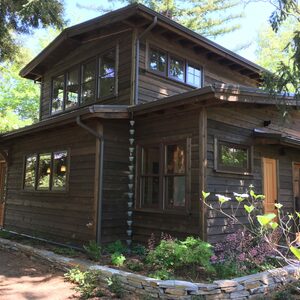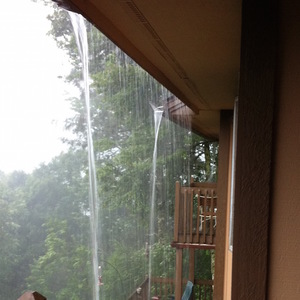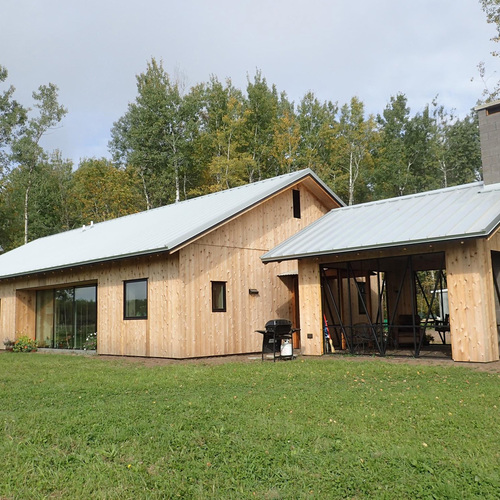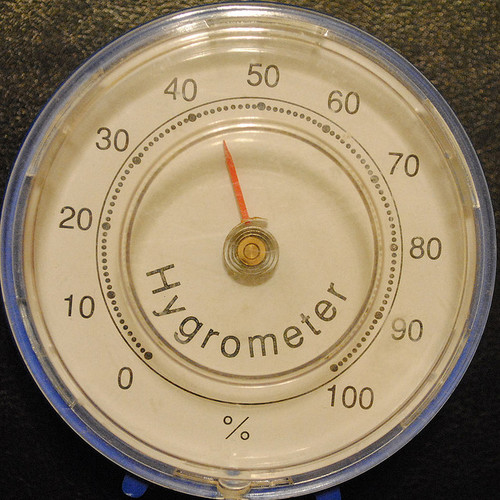
A little water goes a long way We hear a lot about how moisture can be an indoor pollutant in tight houses. But just how much moisture can be a problem; how does boiling a pot of water compare to a 15-minute shower? This keeps some of us mold worrywarts up at night, so I thought it would be a good idea to run some numbers. In the table below, look at how little water it takes to raise the relative humidity (RH) from a reasonable 50% interior RH to a mold-marginal 70%: MOISTURE CONTENT: 800-square-foot apartment (6,400 cubic feet of interior space)
| Temperature (ËšF) | Starting Relative Humidity (%) | Starting water content of apartment air (pints) | Add this much water to the apartment air (pints) | Resulting Relative Humidity (%) |
|---|---|---|---|---|
| 65 | 50 | 3.0 | 1.4 | 70 |
| 70 | 50 | 3.6 | 1.6 | 70 |
| 75 | 50 | 4.4 | 1.8 | 70 |
Source: Nathan Yost, 3-D Building Solutions An interior RH of 70% will make just about everyone uncomfortable (see “Comfort Comes with Green Building“). It also means that cooler surfaces in the home can approach the dew point, a condition that mold and dust mites just love. Moisture sources in the home The table above tells us that adding less than a quart of water (2 pints) to this apartment’s air can be a problem; but just how much water is that? Time for table number 2: Common Moisture Sources in the Home (family of 4)
| Source | Estimated Amount of Water (pints) |
|---|---|
| 5-minute shower | .5 |
| Indoor line-drying of clothes | 4 – 6 per load |
| 5 – 7 house plants | About 1 per day |
| Washing dishes (dinner, family of 4) | .7 |
| Cooking (dinner, family of 4) | 1.2 (1.5 with gas cooktop) |
| Respiration/perspiration | .4 per hour |
| Unvented kerosene space heater | 7.6 per gallon of kerosene burned |
| Evaporation – new construction materials | 10+ per day |
| 1 cord green firewood stored indoors over 6-month period | 400 – 800 |
Source: Minnesota Extension Service, University of Minnesota Yikes! For a family of four, cooking dinner, eating, and then washing the dishes adds enough moisture to raise RH to levels that spell T-R-O-U-B-L-E. Turns out that there are lots of ways to dump what ends up to be quite a lot of water into the air. Admittedly, this is a rather small dwelling unit, and there is no air exchange accounted for in the first table. But that is really the point. Every home, but especially an energy-efficient airtight one, needs dedicated air exchange, particularly in high-moisture areas like the kitchen and baths. So keep your eye on moisture sources in the home, ventilate for moisture control, and spring for a hygrometer from Radio Shack for about $20 to keep track of interior RH.
Weekly Newsletter
Get building science and energy efficiency advice, plus special offers, in your inbox.















10 Comments
Another hygrometer option
Lee valley has a reasonably nice looking clock that includes a temperature gauge and Hygrometer that looks alright up on the wall as a permanent reference.
http://www.leevalley.com/wood/page.aspx?c=1&p=52641&cat=1,43456
I found it very useful in resolving humidity/dryness concerns when my wife and I moved into our well insulated and sealed home, which has an HRV.
I didn't want it too humid ( I'm the one who reads the Building Science articles) and understandably she didn't want it to dry.
I was hoping that the VanEE HRV that I purchased would help maintain humidity. Unfortunately, I came to realize it only controls excess humidity, but does nothing to maintain a comfortable humidity level automatically. That is to say that during really cold and dry periods (-20 to -30 C) the interior humidity can drop to levels that would be considered too dry.
When residential HRV's get 'smarter', with variable speed EC motors and controllers that monitor humidity, CO2 and pollutants than we'll no longer need to buy a stand alone hygrometer.
I was looking at the specs for the Recouperator the other day and it seems to be the 'smartest' HRV I've seen so far.
Of course, If you don't have an HRV the above doesn't apply. And to state the obvious Mr. Yost's blog posting is a lesson about why you need a good ventilation strategy, preferably an HRV/ERV.
Can you build an energy efficient and comfortable house without one?
Andrew
Too Dry?
Andrew,
I am curious about your sometimes "too dry" home.
Is the home extremely tight? Do you have blower door results?
Is the home large or small?
How many intentional Air changes per hour are you programmed for?
What humidity level do you consider "too dry"?
I noticed that you are a Passive House fan(me too).. did you build to PH standards?
Humidity
Peter,
Are there more risks involved with humidity in more enclosed places?
I live in a very open house without AC in the republic of Panama.During the rainy season humidity never gets below 75% inside the house.Things get moldy but my family never gets sick.
There is no way to lower the humidity it actually feels pretty healthy. Sometimes the humidity is so high that droplets run down the screen on the windows.
We wash the walls with vinegar to keep the mold off.
To alter this we would have to seal the building and run A/C all day everyday which is obviously far less ecofriendly.
Andrew Coates
Principal Cresolus.
Sustainable, tropical Design
Agreed - pick one or the other. Friends in Panama that sometimes keep things open (allowing mold to get established) and then sometimes close up and run AC (limited ventilation) have reported getting sick from mold.
Interesting question
Andrew,
Your question is an interesting one. I agree that there isn't any reason to believe that tropical levels of humidity are inherently unhealthy. A similar question: I've always wondered why some New England homeowners complain when their homes are "too dry" in the winter. The same people, on vacation in Arizona or New Mexico, say they love the climate, even when the humidity level is extremely low.
In other words, it seems that we all accept a wide range of humidity levels outdoors, or in homes with open windows. Once the windows get closed, however, people accept a narrower range.
Besides human comfort, there's the question of the tolerance of building materials to wide ranges in humidity. Either very dry or very humid air can cause problems in building materials.
HRV to address IAQ & humidity problems in Zone 3 coastal
My 950sf rancher fixer (ca 1952) with an ocean view south of San Francisco could use some help in the IAQ department. I'm wondering how to calc if an HRV will improve the indoor RH, given our normally cool and often damp climate (virtually no CDD). I just have a woodstove & wall heater, no ductwork, so even a simple HRV will be a lot of work for this DIY'er. Fresh air would be welcome, but not if it's going to add to the RH! Thanks!
HRV for SF DIY
Hi Gus -
An HRV can make a space drier if the air outside is drier than the air inside. An HRV will humidify a space if the outside air is more moist (higher relative humidity) than the space inside. Of course, temperature changes as the air is brought in will affect the relative humidity, but in your climate I would not count on the HRV to do any significant dehumidification.
In my climate (Brattleboro, VT), the HRV set up for radon mitigation in our basement acts as a significant dehumidifier in the winter, enough so that we can line dry our clothes in the winter without any increase in relative humidity! You should take a look at the Climate Consultant 4 (CC4) tool and run your weather data in the tool and then go to the Psychrometric Chart to get a sense of your hygrothermal profile over the course of the year. This blog--https://www.greenbuildingadvisor.com/blogs/dept/building-science/climate-consultant-4--can walk you through getting started with CC4.
HRV in radon mitigation
Hi Peter,
Could you explain how you use the HRV for radon mitigation?
Thanks!
HRV for radon mitigation
Sure - per the recommendation of the certified radon mitigation technician we used on my house:
We simply ducted the HRV only in the basement with a 3-speed Fantech HRV. We spent some time determining at what speed to run (11/150/200 cfm) to dilute the basement air enough with outside air to get the reading below 4 pC/l.
So, it's a solution-by-dilution approach.
And yes, we did move the radon sensor around in the basement to make sure that we were getting enough mixing of air so that the readings were representative of just about any location in the basement.
The example is one extreme, but try one with a typical size house and ASHRAE 62.2 ventilation rate in Riverside, California (currently 53F and 14% RH). Even with an ERV, it will require ~100 pints/day (ie, active humidification) to reach recommended humidity levels. Similar numbers with some midwest conditions (say 10F and 75%).
Log in or create an account to post a comment.
Sign up Log in